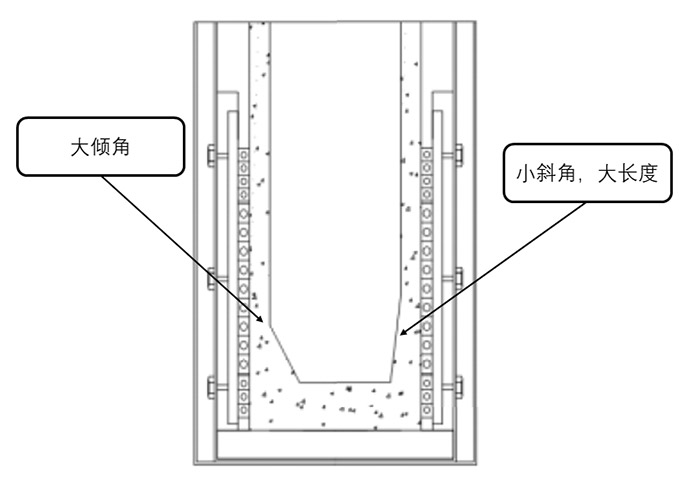- 15
- Feb
Technical requirements for the crucible mold of the induction melting furnace
Technical requirements for the crucible mold of the induction melting furnace
The crucible mold must have sufficient strength during the construction and sintering process, and it must not be deformed during the construction process to ensure that it can transmit vibration energy to the lining material to compact the lining material. The hot surface of the lining material must be in the sintering process. It will not be melted before formation, and will not be locally deformed or melted by the influence of the magnetic field.
Una volta che si verifica la situazione di cui sopra, farà sì che il materiale di rivestimento venga riempito nel vuoto formato dalla deformazione dello stampo, con conseguente diminuzione della densità del rivestimento, influenzando così la resistenza del rivestimento e riducendo la vita del rivestimento liner.
Secondo l’esperienza pratica, lo stampo del crogiolo del forno da 6 tonnellate utilizza un vibratore elettrico per scuotere lo stampo originale del crogiolo in lamiera d’acciaio da 6 mm a 10 mm in tempo reale e lo stampo del crogiolo del forno di fusione a induzione da 20 tonnellate utilizza una saldatura in lamiera d’acciaio A10 spessa 3 mm per garantire che lo stampo del crogiolo ha una forte resistenza, il vibratore non si deforma facilmente durante il processo di martellamento e battitura e l’energia della vibrazione può essere trasferita al materiale di rivestimento del forno attraverso lo stampo del crogiolo per raggiungere lo scopo di compattare il rivestimento del forno, garantendo così la resistenza del rivestimento del forno e garantire la durata del rivestimento del forno.
Le caratteristiche strutturali dello stampo a crogiolo hanno un impatto diretto sulla durata del rivestimento del forno, quindi prestare attenzione ai seguenti aspetti:
1. La circonferenza del corpo principale dello stampo del crogiolo
The circumference of the main body of the crucible mold can be designed to have a slope with a thin top and a thick bottom, or a straight cylindrical shape without slope. The slope is generally controlled at 1~4°, the size of the straight cylindrical crucible mold should be greater than or equal to the safe thickness of the thin part of the furnace lining.
2. Determinazione dell’altezza dello stampo a crogiolo
Si ritiene generalmente che la lunghezza dello stampo a crogiolo dal fondo dello spessore del rivestimento del forno alle dimensioni della parte superiore del corpo del forno. Tuttavia, i seguenti fattori dovrebbero essere pienamente considerati nel processo effettivo: efficienza di fusione, materiali di fusione, parti corrose del rivestimento del forno a frequenza intermedia e copertura del forno.
Under normal circumstances, the bottom of the intermediate frequency furnace for producing gray iron or ductile iron is not very corroded (about 30-50mm), and the upper edge of the lower turn of the induction coil can be pressed.
At the same time, the height of the entire crucible mold should be the distance from the upper plane of the furnace bottom lining to the vertical height of the furnace along the plane plus the height of about 50mm above the furnace along the plane. This height is conducive to the full furnace iron sintering furnace lining, and the specific height does not affect Close the furnace lid.
3. La dimensione e la forma dell’angolo
This is easy to produce; elephant feet; defects, and it is under the lining of the furnace for a long time to be wrapped in molten iron and cannot be observed, so it must be designed accordingly. When the inclination angle is too large, the thickness of the lining can be increased, but it is easy to cause the lining to be knotted, and the mechanical damage of the feeding is also severe; and when it is followed; the small bevel angle is large; after the principle, the later lining is easy to knot here. It is compact, and can really exert the powerful effects of anti-pumping, corrosion resistance and compression resistance at the slope of the furnace lining during the melting process, thereby avoiding “elephant feet” defects and increasing the service life of the furnace lining.
 4. Praticare il foro di sfiato e la forma del fondo
4. Praticare il foro di sfiato e la forma del fondo
I fori a forma di diamante devono essere praticati sul fondo, sulla pendenza e sulle pareti laterali dello stampo del crogiolo a un intervallo di 200 ~ 300 mm, che favorisce lo scarico dell’umidità nel materiale di rivestimento del forno durante la fase di cottura e aumenta la resistenza, e migliora l’effetto di riscaldamento e cottura.
Il diametro del foro è preferibilmente di 3 mm. Se è troppo piccolo, l’effetto di scarico sarà scarso e se è troppo grande, quando il forno viene vibrato, verrà espulsa una grande quantità di polvere di rivestimento dal foro.
The bottom plane of the crucible mold can not be recessed inward, horizontal, or protruded about 1mm from the center, so as to avoid the air gap and structural stress at the bottom of the furnace after the furnace is built, which may cause “bottom explosion” during baking and sintering.
5. Il resto
Tutte le saldature devono essere lucidate in modo uniforme e non sono ammessi solventi di saldatura o spigoli vivi; la tolleranza e la concentricità del cerchio esterno dello stampo del crogiolo devono essere controllate entro 5 mm; lo stampo a crogiolo deve essere pallinato prima dell’uso.
